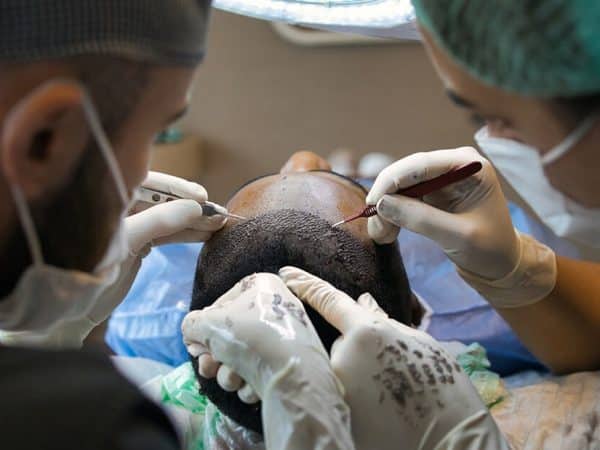Table of Contents
Considering a hair transplant? Have you contemplated undergoing the procedure in Thailand, globally acclaimed for its cutting-edge medical tourism? With top-tier clinics, expert surgeons and affordable prices, Thailand is rapidly emerging as a favoured destination for hair transplants.
This article provides an insightful exploration of hair transplantation in Thailand; why it’s increasingly popular, what the process entails, and how to select the right clinic to suit your needs.
Thailand is rapidly emerging as a favoured destination for hair transplants, globally acclaimed for its cutting-edge medical tourism
Hair Transplantation Explained
Venture into the captivating realm of hair transplantation – an effective solution to hair loss that’s gaining popularity in Thailand.
What is Hair Transplantation?
Hair transplantation refers to a surgical procedure aimed at addressing thinning or balding issues. A surgeon transfers healthy hair follicles from the back of your head (the ‘donor site’) with precision and implants them onto bald or thinning areas (the ‘recipient site’). This safe method provides a permanent resolution for hair loss with results mirroring natural hair growth patterns.
The Science Behind Hair Transplantation
Science significantly contributes to successful hair transplants by constantly advancing technology aligned with our understanding of hair biology. Two major techniques used are Follicular Unit Transplantation (FUT) and Follicular Unit Extraction (FUE), which dominate the field.
In FUT, surgeons remove a strip of scalp from the donor area, divide it into individual follicular units (clusters of 1-4 hairs), and implant them into recipient areas.
Conversely, FUE involves extracting individual follicles directly from the donor site for grafting onto recipient sites. It’s less invasive than FUT and leaves no linear scars behind.
Hair Transplantation: A Global Perspective
Hair transplantation serves as a beacon of hope globally for those dealing with hair loss. With high success rates, this treatment enjoys international acclaim. More individuals are discovering Thailand as an attractive destination to undertake their hair transplant journey.
Worldwide Popularity and Success
Hair transplantation is popular worldwide, with countries like Turkey, USA and India performing over half a million procedures annually. Successful outcomes contribute to this surge in popularity. For instance, when performed by an experienced surgeon, hair transplants have a 90-98% success rate meaning most patients witness significant hair growth post-surgery improving their appearance and boosting self-esteem.
Why Choose Thailand for Hair Transplants?
Choosing Thailand for your hair transplant isn’t just about aesthetics—it’s about value. Known for its superior healthcare system, Thailand offers personalised solutions for hair loss issues with expert surgeons utilising top-tier tools and technologies.
Additionally, affordable pricing makes Thailand an attractive option. FUE surgery costs range from 80-120 Baht per graft in contrast to the 300-500 Baht per graft charged in countries like the US. Furthermore, living expenses during your stay won’t break the bank due to affordable local costs.
A notable highlight of Thai medical tourism is the warm personalised experiences which guiding the patients throughout—from consultation through post-operative care.
While deciding on a hair transplant may not be easy; knowing these advantages might make choosing Thailand your best opportunity not only to regain lost hairs but also revitalise your confidence levels.

Hair Transplant Procedure in Thailand
Thailand leads South-East Asia’s arena of hair transplant procedures. Your journey towards voluminous locks involves three main stages: consultation & pre-surgery assessment, undergoing surgery itself and finally post-surgery recovery & care.
Consultation & Pre-Surgery Assessment
Every individual’s journey starts with a comprehensive consultation and pre-surgery assessment. This step ensures you’re a suitable candidate for the procedure. Expert Thai surgeons evaluate your hair loss grade using specific metrics like the Norwood scale for men or Ludwig scale for women and take into consideration general health and medical history to rule out complications.
The Surgery Procedure
Once you pass the pre-surgery evaluation, surgery begins. Thai surgeons are proficient in both FUE & FUT methods; the choice between these depends on your specific needs and surgeon’s recommendations.
In FUE, individual follicles are extracted from a donor site (usually back of your scalp) and implanted into balding areas; while in FUT, a strip of scalp is removed from the donor site, dissected into individual follicles before transplantation.
Despite seeming complex, surgeries happen under local anaesthesia ensuring minimal discomfort.
Post-Surgery Care & Recovery
The final stage involves post-surgery care & recovery that play crucial roles in achieving best results. This includes instructions about washing hair, recommended sleep position, physical activity limitations & medications for pain relief/preventing infection.
Initial results start showing 3-4 months post-operation with substantial growth noticeable after 6-12 months so patience is key to witness this gradual transformation.
Comparing FUE and FUT Hair Transplant Techniques
In Thailand’s hair transplantation offerings two dominant techniques exist: Follicular Unit Extraction (FUE) and Follicular Unit Transplantation (FUT). Understanding these can simplify your quest to regain lush healthy locks.
Follicular Unit Extraction (FUE)
FUE involves extracting individual follicular units directly from donor sites offering benefits such as absence of linear scarring & shorter recovery times. However, it requires shaved areas on donor sites which some might find inconvenient.
Follicular Unit Transplantation (FUT)
Alternatively, FUT represents a more traditional approach where surgeons remove a strip of scalp from donor sites. Despite being more cost-effective it poses a higher risk of linear scarring and longer recovery periods.
Your choice between FUE & FUT depends on costs, recovery times, scarring preferences, available length and density of your donor hair.
| Procedure | FUE | FUT |
|---|---|---|
| Pros | – No linear scarring – Shorter recovery time | – More cost-effective |
| Cons | – Shaved areas on donor sites (may be considered inconvenient) | – Higher risk of linear scarring – Longer recovery periods |
Hair Transplants in Thailand: Cost Explained
The following sections detail the cost breakdowns, financing options, and cost-effectiveness of Thai hair transplants.
Cost Breakdown and Financing Options
Understanding costs gives a clearer picture of potential investments. The average price range is 50,000 – 200,000 Thai Baht per procedure including consultation fees, surgical costs, medication expenses and aftercare charges. Variations arise due to differences in technique used (FUE or FUT) and number of grafts required.
Fortunately many hospitals offer finance schemes like installment plans making it easier to cover total cost.
Why are Thai Hair Transplants Cost-Effective?
Three main reasons make Thai procedures affordable:
1. Low living costs compared with countries like the UK/US impacting overall medical expenses
2. Stringent medical standards ensuring top-notch services at relatively low prices
3. Government promotion making resources accessible and affordable for foreign patients.
Hair Transplant in Thailand: Success Rates
The hair transplants procuder in Thailand show consistently high success rates whether through FUT (85%-95% success after 12 months) or slightly lower for FUE (80%-90% after same period).
These figures primarily depend on individual patient factors and reflect Thailand’s ability to deliver high success rates across different transplant techniques. The choice between FUE & FUT comes down to personal factors.
Thai hair transplants boast high success rates: FUT (85%-95%) and FUE (80%-90%) after 12 months, emphasizing Thailand’s proficiency across transplant techniques
Potential Risks & Side Effects of Hair Transplant in Thailand
Like any surgical procedure hair transplants may lead to complications; however most clinics in Thailand take measures to minimize risks.
These might include temporary thinning of existing hair, infections/inflammation around new follicles numbness or unusual-looking tufts of new hair. Thai transplant clinics proactively mitigate risks through use of internationally certified surgeons adept at minimizing complications using advanced tools/methodologies and providing professional after-care services.
Conclusion
Consider multiple variables before deciding on a hair transplant: potential risks, clinic reputation/expertise, surgery method, recovery time, cost, and donor availability.
And follow the doctor’s post-surgery instructions for better recovery, overall health, and satisfaction.
The right choice caters to individual needs/preferences, ensuring a healthy/seamless hair transplant journey in Thailand and making intelligent/informed decisions to provide a positive/satisfactory journey to regaining one’s crowning glory.
Accommodation for Comfortable Stays
When you’re traveling to Thailand for medical treatment, it’s important to find a place to stay that’s comfortable and convenient.
There are plenty of hotels and apartments near the medical facilities, so you can choose one based on what you like and need for your stay.
Think about what you’ll need during your stay. If you’ll be staying overnight or for a long time, find a place that feels like home. For shorter stays, a hotel with good amenities can be great.
Make sure you pack everything you’ll need for your trip, like important documents, medications, and any items that will help you relax during your stay.
It’s also a good idea to bring clothes that will be comfortable for your treatment, like loose-fitting clothes for knee surgery or easy-to-wear tops for shoulder surgery.
By planning ahead and choosing the right place to stay, you can make your medical trip to Thailand as comfortable and enjoyable as possible.
Bangkok
Phuket
Frequently Asked Questions About Hair Transplant
Thailand has emerged as a prominent destination for hair transplantation due to its state-of-the-art medical facilities, experienced surgeons, and competitive prices. Patients often choose Thailand not only for the quality of the procedure but also for the opportunity to recover in a beautiful and serene environment.
With a worldwide reputation as a center of excellence for medical tourism, there aren’t many better places to go for a hair transplant than Thailand. Medical tourism is a major industry here and the quality of the care and the facilities are outstanding.
Complications of hair transplant surgery risks of general anesthesia, including allergic reaction, which may (rarely) be fatal. surgical risks such as bleeding or infection. scars that may be severe, raised, reddened and itchy. nerve damage, including permanent loss of sensation.
Individuals with serious health complications. Although hair transplant surgery is a relatively simple procedure that can yield amazing results, those who have chronic health issues like heart disease, kidney or liver failure, diabetes, and more, may not be suitable for such a surgery.
About six months after a hair transplant session, the transplanted hairs begin to take on a natural appearance and will continue to grow for a lifetime. The donor site from which the hair was taken shrinks to a small, barely noticeable incision line that is completely hidden in the surrounding hair.


